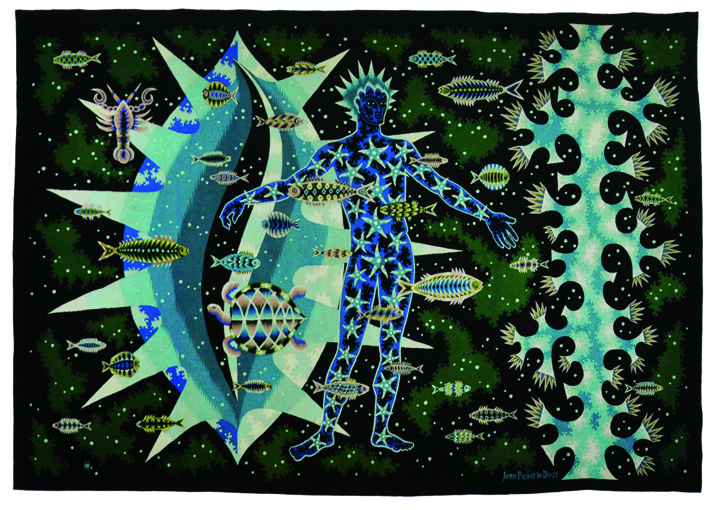
Subtitled “Tapis et tapisseries d’artistes”, this major French exhibition is on view at the Musée d’Art moderne de la Ville de Paris (11 avenue du Président Wilson, F-75116) from 11th October 2013 to 9th February 2014. It presents exhibits by more than 110 artists dating from 1880 to 2000. Its artistic director is Marc Camille Chaimowicz, born in France in 1947 and resident in London, who espouses highly idiosyncratic ideas of art.
The exhibition is divided into five periods in which the artists are categorised. The period from 1880 to 1940 includes early reformers and later Bauhaus artists such as William Morris and Anni Albers; from 1940 to 1970, cartoon painters and graphic artists such as Jean Lurçat and Victor Vasarely or sculptors like Alexander Calder; from 1970 to 1980, Magdalena Abakanowicz and the gamut of participants in the Lausanne Biennials; from 1980 to 2000, Rosemarie Trockel and, surprisingly, Vivienne Westwood; and as of 2000, 32 artists of whom few have featured in the textile scene, such as Pae White, a graduate in painting and sculpture who occasionally has designs of hers executed by an industrial jacquard mill. In the days of Lausanne, Pierre Pauli, the Biennial co-founder, and René Berger, the former Director of the Cantonal Museum of Fine Art at the Palais de Rumine, were keen advocates of the new departures in cartoon tapestries towards the textile arts; both attempted to grasp new developments emotionally as well as intellectually, allowing themselves to be amazed and displaying a productive curiosity. However, under René Berger’s successor the narrow-minded spirit of art scholarship returned to the Biennials, and in the last Lausanne catalogue “tapestry” had turned into “textiles and contemporary art”, illustrating that textiles and contemporary art were considered two separate things! (see TF 3/2012) Then again, art scholars cannot overlook some of the inherent features of traditional tapestries; they have a presence that is both visual and tactile, they are suitable for both aesthetic and functional use, and they are even portable. They transcend the usual boundaries of the decorative and of design. In this context, “Decorum” is something of a framework, a master key for art as perceived by exhibition producers. Some of the catalogue text reads like a carte blanche: everything is possible – anything goes. In his book, “The Art of not making” (see TF 2/2013, p. 40), Michael Petry has expressed similar ideas. The artistic director of the “Decorum” exhibition is a graduate of three London art colleges, one of them the Slade School of Fine Art. All studio staff are practising artists and actively involved in research as well as teaching”. It is people with academic backgrounds such as this who populate the art business, people who lack any reference to textile materials, who have been ploughing through art catalogues since 1980 and who know few people trained in textiles aside from Vivienne Westwood. They have fallen back to Jean Lurçat’s level when he cried out – shocked by the first exhibits presented at the Lausanne Biennials – “Don’t trust those little knitting girls…” Indeed, when female artists explore textile media they will usually cause male art curators to break out in hives. Fear of this prejudice has prompted Rosemarie Trockel, herself a former teacher trainee and applied art student, to adopt an aggressively feminist attitude that has gained her knitter-phobic work the highest accolades in the art trade (http://www.mam.paris.fr/node/790). Nevertheless the Paris show attempts the break with the traditional hauteur of the current thinking in art history. Like Wolfsburg, it seeks to present ‘new’ angles on the subject and to give prominence to perspectives that transcend specific periods and cultures (cf. catalogue review)